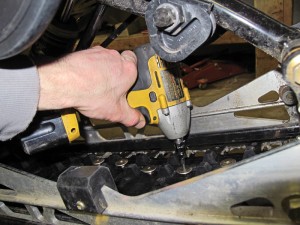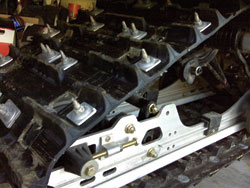Stud Boy Super-Lite Pro Series Backer Plates Review
Different metals and materials that reduced weight or increased durability have improved rear-end traction products for snowmobiles recently, but advancements in snowmobile studs have been pretty insignificant since push-through studs effectively replaced T-nut studs in the early 1990s. Fast forward two decades to today and Stud Boy has what might prove to be the first “revolution” in snowmobile traction in more than two decades.
Super-Lite Pro Series Backer Plates are a polymer backer plate/nut combination that also provides traction. We installed 153 Stud Boy Power Point studs and as many of the new single backers in our 2012 Arctic Cat ProCross F 800 Sno Pro, along with a set of 6-inch Shaper bars on the skis.
The backers added a considerable amount of acceleration and braking traction. Snow was well set-up in most of the areas we rode our F 800 last winter, and the backers hooked into the crusty snow when we hit the throttle. When braking, the scoop shape of the backers helped scrub off speed more quickly than a traditional backer and stud combination. They helped stabilize the track through turns, too.

Difficult Installation
In addition to providing traction, another feature that makes Super-Lite Pro Series Backers unique is their self-tapping design that eliminates the need for separate nuts. This reduces weight and, theoretically, makes installation easier.
To mount a traditional push-through stud system, installers drill holes, push the studs through those holes, set the backers and nuts in place and then tighten the nuts. But when using Super-Lite Pro Series Backers, there are fewer steps.
After drilling the hole and pushing the stud through, the next step is to set the Pro Series Super-Lite backer plate on the stud and, with correct orientation, hold it with the special T-handle tool from Stud Boy. With everything lined up, the stud can be screwed into the backer. This is where installation became difficult for us, though.

Cordless impact wrenches work well to install studs. We’ve been using a 3/8-inch drive tool for the past five or six years with great success because it’s powerful, compact, lightweight and works quickly to tighten the nuts. But with confined space inside the rear suspension of our Cat, it was a painstakingly tedious process to fit the impact wrench inside the track to tighten all of the studs into the backers.
Difficulty was compounded by the fact that either the pocket on the stud that engages with the 3/16-inch Allen tool or the Allen tool itself was manufactured on the loose end of the tolerance scale. This caused our Allen tool-equipped impact wrench to slip out if it wasn’t lined up perfectly to squarely index the bit into the stud, which ruined the Allen pocket of about a dozen studs and rounded the corners on three bits while trying to tighten 153 studs. We followed Stud Boy’s tip to let the backers soak in warm, soapy water during installation to soften the material and provide lubrication.
The Future Of Backer Plates?
While studs will help prevent any track from washing out through turns and aid in braking, the scoop profile of the Stud Boy Super-Lite Pro Series Backers further limits lateral movement. The extra points and scooped edges bit into the snowpack and helped keep the rear end in line, but it also caused more inside ski lift.
In terms of stud quantity, pattern and backer selection, we followed Stud Boy’s traction setup recommendations for this sled to a ‘T,’ but next time we’ll probably incorporate traditional backer plates on the outside rows of the track to allow a little more slip when driving through corners and reduce inside ski lift.
We rode 600 miles on our Stud Boy Super-Lite Pro Series setup. Durability during our testing was as good as any other polymer backer we’ve used, especially considering that snow conditions last winter were usually only fair — at best. Inspection at the end of the season didn’t reveal any broken or flattened tips. The studs suffered normal wear to the leading edge of the stud body.
Will the Stud Boy Super-Lite Pro Series Backers concept catch on? We don’t see why not because they add more traction and pricing is similar to traditional backers, plus Stud Boy has taken steps to make installation easier.
The new Pro Series Installation Tool ($24.99) is available and can be driven by a socket so the single-stud backer plates can be screwed on the stud while the stud is held stationary with an Allen wrench. Knowing that, we see no reason why we wouldn’t install Super-Lite Pro Series Backers in the future.
Stud Boy
Ravenna, Michigan
231/853-2323
studboytraction.com





I found this article very useful. I am new to snowmobiling but not motorsports. I do motorcycle trackdays often and use to the bike sliding around under me at 130mph in corners as well the exceptional braking today’s sportbikes offer. After riding last season with not so stellar conditions and alot of ice, I was looking for better handling, traction and braking. I am mechanically inclined and always looking to learn. After reading this article, I started reading up on the Super-Lite Pro Series Backers to use in my first attempt at studding my 2012 F800 and seemed like a good option offering a lot of what I was looking for.
I used a Dewalt impact driver which I think is a must for installing studs. I took note of the “Difficult Installation” notes you mentioned. Instead of holding the backer with the tool, I used a 1″ socket on the backer holding tool and used the impact drill to secure the backer to the stud by holding the stud. This prevented me from having to get the drill under the track, not wearing through 3/16″ allen head sockets and not stripping out the head of the studs.
I also used the Super Lite single backers on the outside with the normal nuts. With my order, I have extra Super-Lite Pro-Series backers, regular Super-Lite single backers and studs just incase I want to try out the Pro-Series on the outside as you did for this article.
Used these backers on a couple different XRS’s. Absolutely loved them. They are a must have. Just don’t over tighten on installation with driver. Use the torque wrench the last few turns so you don’t strip the stud or bit. Far lighter than aluminum backers. Plus added traction. I weighed them myself. They hold together better than anything else I’ve ever used.